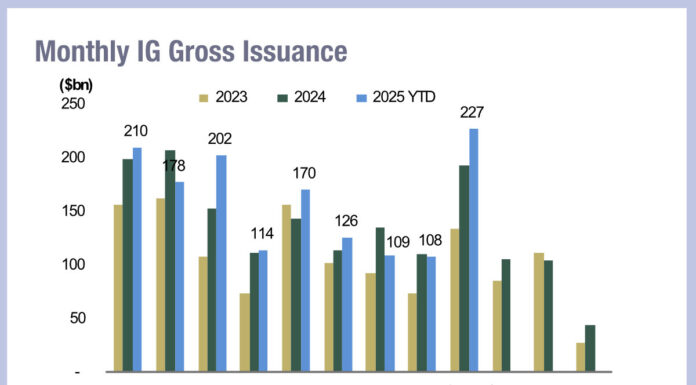Portfolio Trading – Technology is the Answer

Portfolio trading (PT) is transforming the Fixed Income market. It is no longer niche – in the US it now accounts for 12% of all bond trading according to TRACE data, with an impressive 66% increase in volume year on year.
In US credit it is estimated that PT now accounts for around 30% of D2C activity, and driven by this growth, some of the larger buy-side firms also use it to trade Rates. And PT isn’t limited to the US – it is also growing significantly in Europe.
The Desk speaks with David Ellengold, Business Analyst at TransFICC, about the evolution of this market, the venues which support it, how their workflows differ, and how the deployment of technology is the only way for Dealers to successfully manage this flow.
How do you define Portfolio Trading?
PT in fixed income involves executing an entire bundle of bonds in a single, all-or-none transaction, rather than trading them individually. PT is an efficient way for the buy-side to deal with large, complex and multi-faceted bond transactions.
Originally launched in 2019, it came of age during COVID, when speed, certainty and efficiency mattered most. A large number of Dealers have adopted this way of trading, either on venues or direct (or both), hoping that by supporting their clients it would lock in flow.
PT was designed primarily as a risk transfer protocol for corporate bonds, where full execution is supported across buy and sell orders, with different price types such as par price, yield and spread to a benchmark or reference price like BVAL.
A PT can be made up of any number of bonds. The number of list items can be in the hundreds, but depending on the size, many Dealers must price each bond individually. Clients compare each Dealer’s pricing by looking at the total proceeds paid or received based on the prices quoted for each bond.
Pricing based on a spread to a reference is becoming more common. Some venues refer to this as a Market On Close workflow, rather than a PT.
Which venues support PT?
Tradeweb originally launched in PT for US and EU Credit in 2019. They added European Govvies in April this year, which was essentially an update of the prior All or None workflow.
Seeing client adoption other venues have followed suit. Now MarketAxess, Bloomberg, Trumid, and MTS BondVision also support PT.
How do venues differ in terms of workflows?
PT workflows can be highly complex. PT is an umbrella term, but like most things in Fixed Income, if you look beneath the surface there are many differences in how venues manage workflows.
Each venue typically splits portfolio workflows into two types – one with traditional price types such as price, yield or spread and the other where bonds are priced at a spread to a reference price of some kind. Reference price sources can be an index such as BVAL, the dealer’s own pricing or even a custom source specified by the client.
Dealer workflows are also complicated, as they need to quote and book trades that are multi-directional, multi-currency, and can be a combination of price types.
API behaviors also differ, in some cases significantly. Some venues, as you would expect, follow All or None workflows while other venues have a hybrid All or None/Non-contingent model where the venue allows a Dealer to price a subset of the PT. This gives Dealers the opportunity to quote most of the portfolio but not quote on any bonds where perhaps they don’t hold inventory or don’t have credit available. Using this workflow, the client can then choose to hit a subset of the quotes if they wish.
As with all credit workflows, bonds that are traded as a spread must be spotted to confirm the par price. A PT can contain a mixture of bonds priced as a spread and others that are not. This results in different negotiation steps for each after the PT has been traded.
What are the advantages and disadvantages?
Buy-side clients benefit from cost, convenience and efficiency. Trading using PT saves time and effort. As tools like pre-trade and intra-trade analytics evolve results are improving.
Dealers’ opinions of PT broadly fall into two categories. For some smaller players there is the administrative burden of supporting these workflows, combined with siloed desks and P&L issues (where winning the PT means that some desks make a profit and others have to manage small odd lots, or even book losses). On the other hand, PT tends to benefit the larger Dealers, which have more balance sheet flexibility. Many of these have invested in technology to automate these workflows and even set up portfolio desks to capture growing volumes of PT trades.
How can technology help?
Managing PT using manual workflows is not sustainable, especially as PTs are often concentrated around month end or quarter end. Volumes are growing, and workflows are complex. Quote analytics are improving, putting pressure on accurate and competitive pricing, and market velocity is increasing as more data becomes available. This means that the first one or two PT quotes received from Dealers with consistently competitive pricing are likely to win the trade, whereas quotes from Dealers which price manually (and more slowly) may not even be seen by the client.
Without technology, pricing is done in one system, booking in another, and reporting in a third. Add to that the rekeying required to demonstrate best execution, timestamps, reconciliations, and audit trails.
How do you think PT will evolve?
Interest in PT seems to be growing. We have seen this firsthand where Dealers want to use our One API service to price PTs. In this example, our service sends a request message to the Dealer for each line item that contains a list ID to link them together and the number of items in the portfolio. The dealer can then automatically route each line item to the appropriate desk for pricing. When each item has been priced by different desks the Dealer sends back one quote message for the whole PT.
This is largely a client driven initiative, so Dealers looking to capture flow will continue to support it. But they can only manage volume by using technology to automate routing to different desks, for quoting, negotiation, booking, risk management and reporting.
©Markets Media Europe 2025












